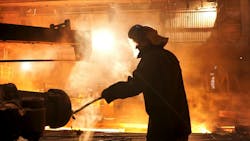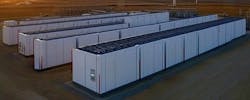Revolutionizing Steel Production: Nucor's On-Site Battery and Solar Power Integration
The largest U.S.-based steel producer is now using on-site battery storage to help power operations and maintain energy resiliency at its bar mill in Kingman, Arizona.
Nucor Corp. contracted clean energy project developer Ameresco to develop the 50-MW/200-MWh battery energy storage system (BESS) for Nucor’s facility. What the companies called the largest behind-the-meter project in Arizona was put into commercial operation this month.
The Nucor battery storage component, combined with solar and grid connection, powers the bar mill and improves on-site emissions along with the installation of a new electric arc furnace.
“We are thrilled to have been selected for this groundbreaking BESS project,” said Jonathan Mancini, Senior Vice President - Solar & BESS Project Development at Ameresco, in a statement. “By placing a battery energy storage system onsite at Nucor’s Kingman plant, we are helping to support their expansion and create a more resilient, reliable and clean energy future.”
The BESS is composed of 58 Tesla Megapack 2XL units under a 20-year Storage Services agreement with Ameresco, which owns the system. The batteries were installed at the Nucor substation and will be operated by the Arizona Electric Power Cooperative.
The electricity used at the Nucor bar mill site includes the solar array, the BESS and local grid power. The solar power also charges up the battery system, which can directly discharge to support bar mill operations, stabilize electric load from the new arc furnace and provide power during grid outages.
“The battery energy storage system at our Kingman mill is a site-specific solution developed in response to the unique grid that serves the plant operations and smooths out our energy demand,” said Matt Blitch, Vice President & General Manager at Nucor. “We’re grateful for the collaboration with Ameresco and our utility partners to deliver a system that supports our expansion and maintains operational reliability.”
Nucor is expanding the Kingman facility, which will boost the company’s annual production to about 600,000 tons. Four years ago, Nucor announced it was allocating $100 million toward building a new melt shop at the Kingman bar mill.
Nationwide, Nucor’s bar mills manufacture a variety of steel products including concrete reinforcing bars, hot-rolled bars, structural angles, wire rod and highway products in both carbon and alloy steels.
GreenFront Energy Partners advised Nucor on the contracting and structuring of solar and storage solutions at Kingman.
Steel manufacturing is an energy-intensive and environmentally challenging industry in which the greenhouse gas emissions produced weigh roughly twice as much as the steel itself, according to Science.org. The steel industry produces about 7% of global greenhouse gas emissions.
Among its attempts to deteriorate steel manufacturing the industry has tried carbon capture, renewable energy and utilizing hydrogen for energy resources. Two years ago, Nucor signed a long-term solar power purchase agreement with NextEra Energy Resources to offset power from its operations in Ghent, Kentucky.
Nucor leads all U.S. steel producers and ranks 15th globally with 18.5 million tons produced annually, according to the World Steel Association.
About the Author
EnergyTech Staff
Rod Walton is senior editor for EnergyTech.com. He has spent 17 years covering the energy industry as a newspaper and trade journalist.
Walton formerly was energy writer and business editor at the Tulsa World. Later, he spent six years covering the electricity power sector for Pennwell and Clarion Events. He joined Endeavor and EnergyTech in November 2021.
He can be reached at [email protected].
EnergyTech is focused on the mission critical and large-scale energy users and their sustainability and resiliency goals. These include the commercial and industrial sectors, as well as the military, universities, data centers and microgrids.
Many large-scale energy users such as Fortune 500 companies, and mission-critical users such as military bases, universities, healthcare facilities, public safety and data centers, shifting their energy priorities to reach net-zero carbon goals within the coming decades. These include plans for renewable energy power purchase agreements, but also on-site resiliency projects such as microgrids, combined heat and power, rooftop solar, energy storage, digitalization and building efficiency upgrades.

